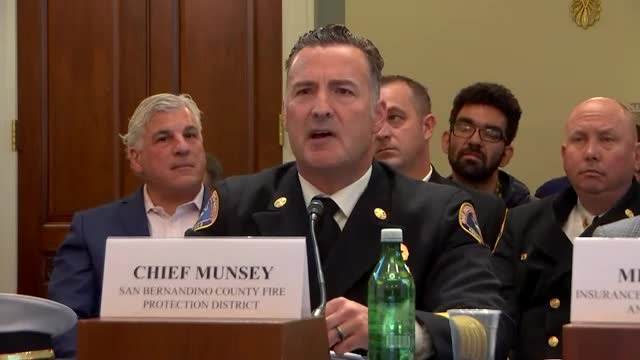Roy Wright advocates for unified wildfire risk mitigation strategies in local neighborhoods
May 16, 2025 | Natural Resources: House Committee, Standing Committees - House & Senate, Congressional Hearings Compilation
This article was created by AI summarizing key points discussed. AI makes mistakes, so for full details and context, please refer to the video of the full meeting. Please report any errors so we can fix them. Report an error »

The Oversight and Investigations Subcommittee of the U.S. House Committee on Natural Resources convened on May 16, 2025, to address critical issues surrounding wildfire management and community safety. The meeting focused on the increasing frequency of wildfires and the need for effective land management strategies to protect homes and communities.
The session began with a discussion led by a committee member who emphasized the urgent need to understand the root causes of house fires, particularly in the context of recent wildfires in Los Angeles, such as the Eaton and Palisades Fires. The member pointed out that while wildfires are a factor, the primary issue lies in local government failures to manage land effectively and protect residential areas. The importance of maintaining control lines and access routes for firefighting efforts was highlighted, with historical comparisons made to fire management practices from the 1930s.
Visual aids were presented to illustrate the changes in land management over the decades. The member noted that poor management has led to increased fire spread, as evidenced by the Line Fire in San Bernardino, which burned 50,000 acres and necessitated the evacuation of thousands. The discussion underscored the need for proactive land management rather than reactive measures taken after fires occur.
Following this, Roy Wright, representing the Insurance Institute for Business and Home Safety, provided insights into the organization’s research on wildfire risks. He stressed the importance of making homes and communities more resilient to severe weather events through smart mitigation strategies. Wright outlined essential measures homeowners can take to reduce fire risks, such as using ember-resistant materials and maintaining defensible space around properties.
Wright also presented a successful case study of the Dixon Trail community near San Diego, where homes were built to high wildfire preparedness standards. He advocated for more developments like Dixon Trail, which incorporate collective risk reduction strategies at both the home and neighborhood levels.
The meeting concluded with a call for coordinated efforts among federal, state, and local policymakers to address fuel loads in wildland areas and enhance community resilience against wildfires. The discussions highlighted the critical need for improved land management practices and proactive measures to safeguard homes and communities from the devastating impacts of wildfires.
The session began with a discussion led by a committee member who emphasized the urgent need to understand the root causes of house fires, particularly in the context of recent wildfires in Los Angeles, such as the Eaton and Palisades Fires. The member pointed out that while wildfires are a factor, the primary issue lies in local government failures to manage land effectively and protect residential areas. The importance of maintaining control lines and access routes for firefighting efforts was highlighted, with historical comparisons made to fire management practices from the 1930s.
Visual aids were presented to illustrate the changes in land management over the decades. The member noted that poor management has led to increased fire spread, as evidenced by the Line Fire in San Bernardino, which burned 50,000 acres and necessitated the evacuation of thousands. The discussion underscored the need for proactive land management rather than reactive measures taken after fires occur.
Following this, Roy Wright, representing the Insurance Institute for Business and Home Safety, provided insights into the organization’s research on wildfire risks. He stressed the importance of making homes and communities more resilient to severe weather events through smart mitigation strategies. Wright outlined essential measures homeowners can take to reduce fire risks, such as using ember-resistant materials and maintaining defensible space around properties.
Wright also presented a successful case study of the Dixon Trail community near San Diego, where homes were built to high wildfire preparedness standards. He advocated for more developments like Dixon Trail, which incorporate collective risk reduction strategies at both the home and neighborhood levels.
The meeting concluded with a call for coordinated efforts among federal, state, and local policymakers to address fuel loads in wildland areas and enhance community resilience against wildfires. The discussions highlighted the critical need for improved land management practices and proactive measures to safeguard homes and communities from the devastating impacts of wildfires.
View full meeting
This article is based on a recent meeting—watch the full video and explore the complete transcript for deeper insights into the discussion.
View full meeting